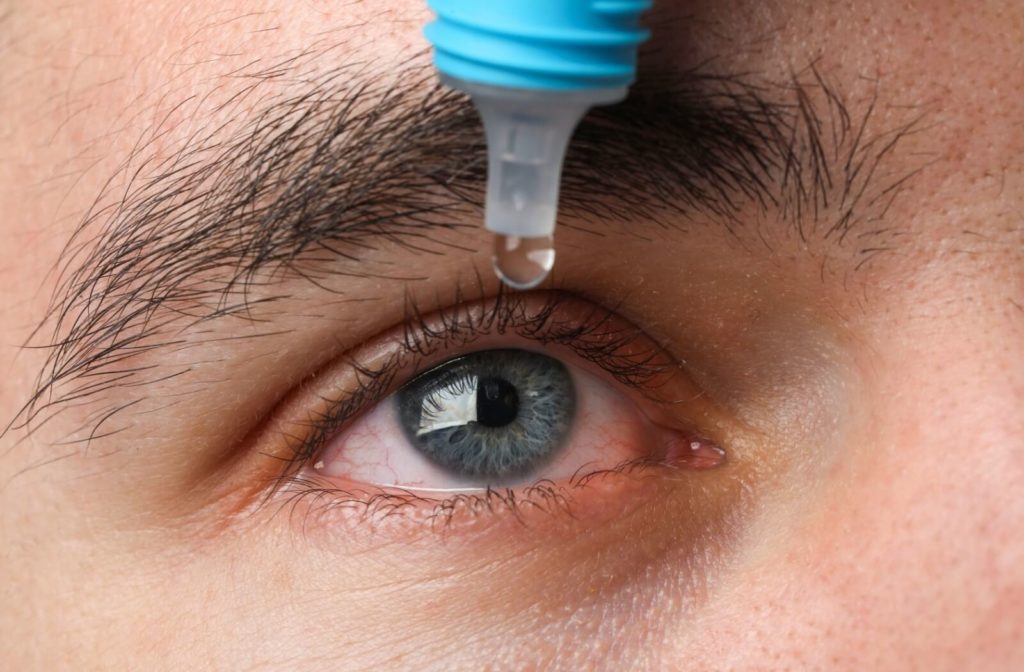Dry eye disease can cause long term discomfort and several complications when it’s not treated. In some cases, dry eye can lead to blindness if it causes damage to the cornea that results in scarring.
Proper management and treatment of dry eye symptoms can help you avoid severe complications and see comfortably. Regular eye exams are important if you often have dry eyes. By taking a close look at your eyes, we can recommend treatments and at-home habits that can prevent and reduce your dry eye symptoms.
Understanding Dry Eye
Dry eye disease, often referred to as dry eye, occurs when your eyes fail to produce enough tears or when your tears evaporate too quickly because of a dysfunction in the glands in your eyes that affects what your tears are made of.
This lack of moisture can lead to various symptoms, such as:
- A burning or stinging sensation
- Redness
- Blurred vision
- Watery eyes
- A gritty feeling, as if something is in your eye
- Sensitivity to light
- Difficulty wearing contact lenses
Causes of Dry Eyes
Several factors can contribute to the development of dry eyes, including:
- Age: Decreased tear production is common for many older adults.
- Environmental Factors: Wind, smoke, and dry air can speed up tear evaporation.
- Prolonged Screen Use: Extended use of digital devices can reduce blinking frequency, exacerbating dryness.
- Medical Conditions: Conditions like Sjögren’s syndrome, rheumatoid arthritis, and diabetes can affect your tears.
- Medications: Certain medications may decrease tear production, including antihistamines, decongestants, blood pressure medications, and antidepressants.
- Hormonal Changes: Hormonal fluctuations can lead to dry eyes, particularly those that occur during menopause.
Possible Complications
Dry eye can lead to various conditions that may significantly affect your vision if not addressed. It’s important for those experiencing dry eye symptoms to be aware of these potential issues.
Corneal Damage
Your cornea, the clear front part of your eye, is essential for focusing your vision. Without sufficient lubrication, the cornea can become irritated and develop small abrasions, which may progress into more serious issues or lead to scarring. This damage can affect vision clarity, increase light sensitivity, and cause considerable discomfort.
Infections
Tears play a crucial role in protecting the eyes by removing debris and supplying nutrients and antibodies that guard against infections. Reduced tear production can weaken this natural defence, increasing the risk of infections such as:
- Conjunctivitis: Also known as pink eye, this is an inflammation or infection of the eye’s outer membrane and inner eyelid.
- Keratitis: This is an inflammation or infection of the cornea, which can be caused by bacteria, viruses, fungi, or parasites.
If not treated properly, these infections can become severe and potentially lead to vision loss.
Inflammation
Chronic inflammation from dry eye can damage eye tissues over time. This persistent inflammation may cause:
- Continuous redness and irritation: Persistent inflammation can make the eyes appear red and constantly irritated, affecting daily comfort and quality of life.
- Meibomian gland dysfunction: The meibomian glands produce the oily layer of the tear film that prevents evaporation. Chronic inflammation can impair these glands’ function, worsening dry eye symptoms.
Inflammation not only worsens dry eye symptoms but can also create a cycle where increased dryness leads to more inflammation, perpetuating the issue.

Preventive Measures for Managing Dry Eyes
Effectively managing dry eyes involves addressing both the root causes and alleviating symptoms. Here are some strategies to consider:
Artificial Tears
Artificial tears are available over the counter and are designed to lubricate the eyes, providing temporary relief from dryness. They are available in different viscosities, including:
- Low-viscosity artificial tears: These are more fluid, offering quick relief, but may require frequent application.
- High-viscosity artificial tears: These are thicker and can provide longer-lasting relief, although they might cause temporary blurred vision.
Lifestyle Changes
There are several lifestyle adjustments that may help alleviate dry eye symptoms:
- Reduce Your Screen Time: Prolonged digital device use can lower blink rates, leading to dryness.
- Use Humidifiers: Adding moisture to the air with a humidifier, especially in dry indoor environments, can reduce tear evaporation and enhance comfort.
- Wear Sunglasses: Wraparound sunglasses can shield your eyes from wind and dust, which can aggravate dryness.
- Stay Hydrated: Drinking ample water is crucial for overall hydration and healthy tear production.
Warm Compresses
A warm compress can help open the oil glands in the eyelids, providing relief. You can make a warm compress at home or you can purchase specialty eye masks made to help with dry eyes.
Dry Eye Therapy
At Queensway Optometric Centre, we provide tailored dry eye therapies to improve the quality of your tears and support overall eye health. We can recommend specific treatments and remedies based on our examination of your personal eye health. In some cases, we may go beyond standard eye drops and recommend other in-office procedures like LipiFlow.
Dry Eyes & Vision Health
Although dry eyes rarely lead to blindness directly, they can cause significant complications if left untreated. By maintaining eye health through regular exams, lifestyle modifications, and appropriate treatments, we can help you avert severe consequences and address dry eye during its early stages.
Don’t let dry eyes compromise your quality of life. Whether you are experiencing mild irritation or more severe symptoms, our experienced team at Queensway Optometric Centre can help. Schedule your appointment with us today!


